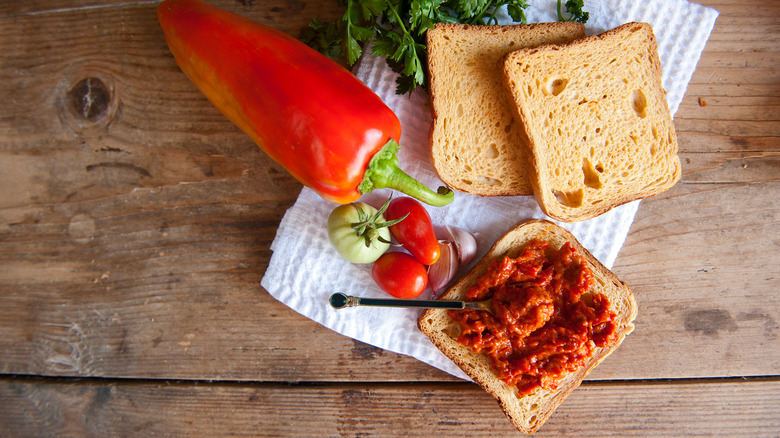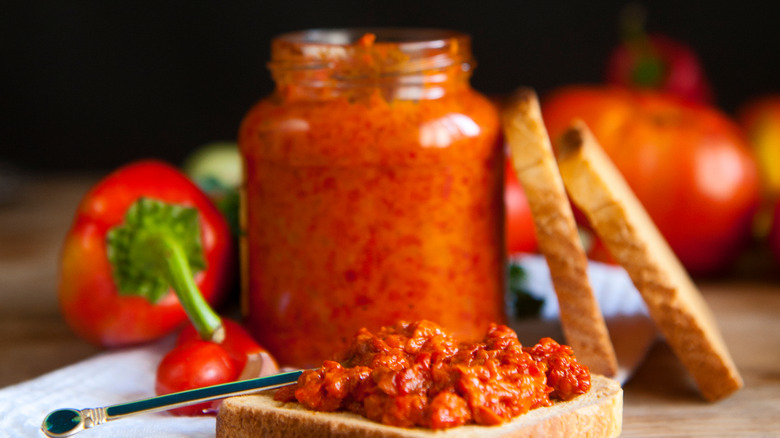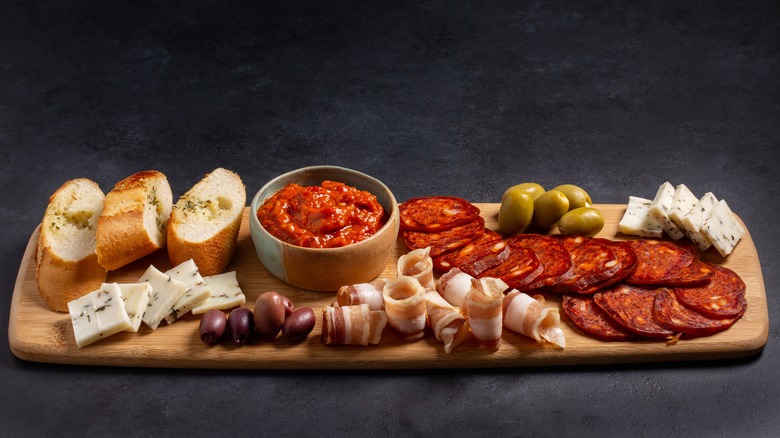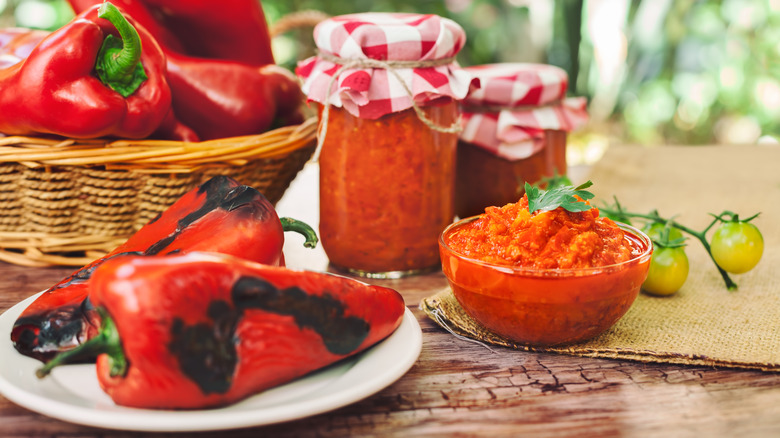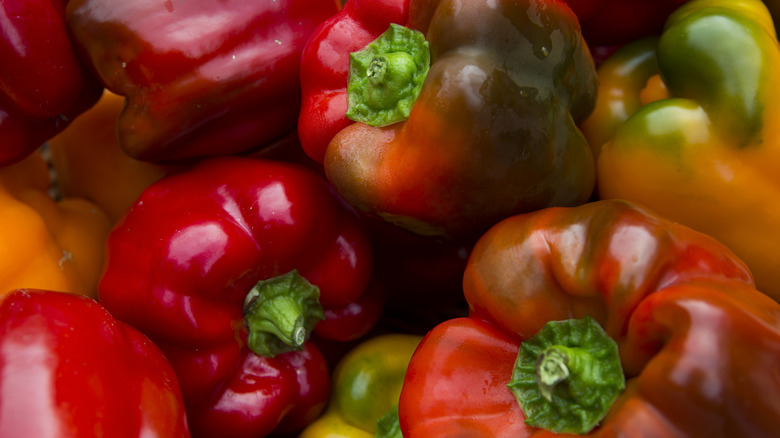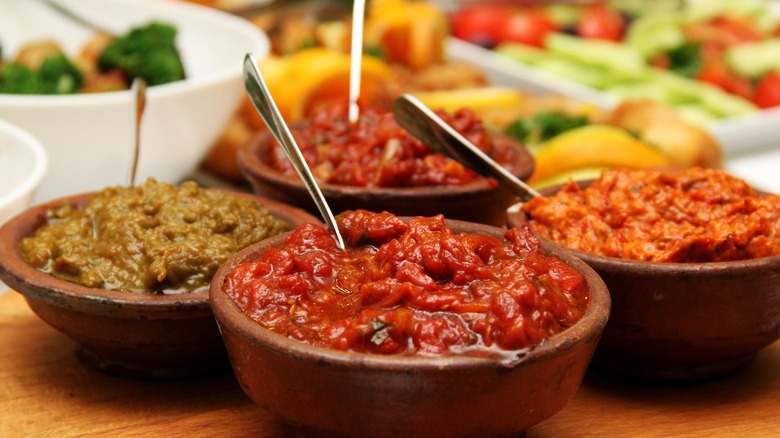What Is Ajvar And How Do You Eat It?
The world is full of food arguments. Big questions like who first invented hummus, how to top a hot dog, and how much pineapple goes on pizza have plagued cultures for decades, if not centuries. The Balkan region is no exception to this habit, and one of the biggest food arguments of the area is over the classic dish ajvar.
Ajvar — pronounced I-var — is a versatile dish that is loved throughout the region, and has sparked many a food fight (via BBC). Ajvar is primarily made from roasted red bell peppers and can be used as a sauce, spread, or dip. It's highly common throughout the Balkans but is often made with small variations between regions, countries, or even towns.
According to the BBC, after singer Dua Lipa referred to ajvar as an Albanian delicacy, angered Serbians spoke out to claim the dish as their own, which in turn drew the ire of proud North Macedonians who also claimed the dish. Despite the controversy, this vegan-friendly dish is a favorite food for the region no matter which ingredients are included.
What is Ajvar?
There are tons of variations to Ajvar. According to the BBC, the most basic recipe consists of roasted red peppers, salt, oil, and vinegar. Some of the more common additions are eggplant and garlic (via MezeHub). The first published recipe for Ajvar comes from the Great Serbian Cookbook by Katarina Popović which was published in the 19th century.
Popović's recipe happens to include eggplant, but the only ingredient that seems to be absolutely essential is the roasted red peppers. According to the food blog Ajvar, Kurtovska kapija red peppers are preferred for ajvar, though chefs can substitute red bell peppers, if necessary. The history of ajvar is tied directly to the pepper. It's considered a winter dish because peppers are harvested and used for ajvar in the Fall, according to Ajvar.com. They are then stored in jars, and enjoyed throughout the winter until fresh vegetables return in Spring. These days ajvar is enjoyed throughout the year (via BBC).
Some recipes char the peppers over a charcoal fire for smokiness, while others prefer the less intense heat of an oven. From there, the peppers are peeled and added to a food processor with any other desired ingredients (via Chasing the Donkey). The paste is then transferred to the stove where it is left to cook down and allow the flavors time to come together.
How to use Ajvar
Ajvar is an extremely versatile dish that almost defies classification. It can be used as a relish, sauce, dip, or a simple spread (via MezeHub). Whether it's served on the side, as a condiment, or as a main course, adding a little ajvar can add a savory punch to any meal, according to the Washington Post. Chasing the Donkey explains, that ajvar is often is alongside some ćevapi which is a type of sausage that's also common throughout the Balkan region. It can be served alongside some pule cheese too if you can afford it. It's a common sight on meat and cheese platters called Meza as well (via BBC), and can also be added to meats, omelets, and pasta. Its smoky, sweet flavor just begs to be experimented with.
Ajvar is actually sometimes referred to as the "Balkan Caviar," according to the BBC, and can be enjoyed by itself, on crackers, or as a crostini spread. This nickname may stem from the 19th century when peppers and oil were considered luxurious in Belgrade, or simply because the two dishes are enjoyed in a similar manner. Regardless, the similarity is what gave the spread its name, which comes from the Turkish word 'havyar' which translates to 'caviar'.
Where to get Ajvar
Ajvar has become increasingly common outside of the Balkans over the years thanks to immigrants from the Balkans spreading around the globe (Via BBC). In the globalized world of the 21st century, it can even be purchased online through Amazon or Walmart. Any maximalists out there can also try ALL of the ajvar by checking out MezeHub. The online retailer sells more than 50 different brands of the tasty orange spread and ships across the nation from their Washington D.C. distribution hub.
Trader Joe's even has their own ajvar, though they haven't made use of the product's reputation for advertising help. The product is given the ambiguous title of "Red Pepper Spread with Eggplant and Garlic", but as more people discover ajvar for themselves, they've confirmed that there's a definite influence (via Kitchn). Maybe they just wanted to avoid some of the controversies over what constitutes ajvar, but it seems like an odd choice.
Nutritional Information
Ajvar hits all of the modern dietary trends as a vegan and gluten-free spread. Since it consists of mostly vegetables it also has plenty of nutrients packed into every bite, and a relatively low-calorie content (via MyFitnessPal). According to Ajvar, the slow cooking process helps to retain much of the vitamins and minerals in each ingredient. The roasted red peppers contribute plenty of iron along with vitamins A and C (via Ajvar.com). If you choose to add eggplant you're also adding the benefits of vitamins B12, folic acid, and chlorogenic acid, which is believed to help fight cancer, and lower bad cholesterol (via Ajvar.com and Washington Post).
Garlic also boasts plenty of nutritional boosts if you choose to buy ajvar that uses it or add a few cloves to your recipe. Garlic is said to do everything from lower your blood pressure and cholesterol to improve athletic performance and extend your overall life expectancy (via Healthline). While it may be sacrilege for some to add garlic to ajvar, it's got some undeniable benefits coming along with it.
Ajvar variations
As mentioned above, there are plenty of different takes on traditional ajvar that exist throughout the Balkans. There are also plenty of other similar dishes that exist along with it. Mild or hot ajvar is made by simply adding chili pepper to the mix, according to Ajvar. The outlet also describes ljutenica, another famous cousin to the spread that combines sweet and hot peppers with tomatoes, garlic, and parsley. Another option to try is 'green ajvar' or malidzano, which uses green peppers instead of red, along with eggplant and mustard. Last but not least, there is pindjur, which upgrades standard ajvar by adding tomatoes and garlic.
for anyone who's looking to dip their toes into the rich world of regional Balkan cuisine, there's no shortage of options out there and ajvar is a great place to start. While you're at it, be sure to sample a glass of rakija, a Balkan fruit brandy.
